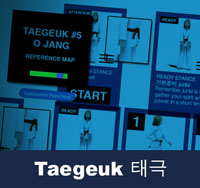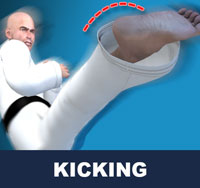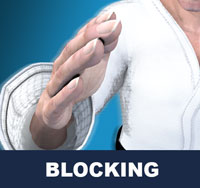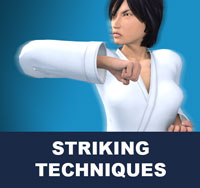Taekwondo 태권도Taekwondo Preschool
Taekwondo is known for its emphasis on high kicking and fast hand techniques, which distinguishes it from other popular martial arts and combat sports such as karate. However, the World Taekwondo (WT) believes that because the leg is the longest and strongest limb a martial artist has, kicks thus have the greatest potential to execute powerful strikes without successful retaliation.
View Taekwondo 태권도 »

Improving Performance through Sport Psychology
Sport psychology involves the study of how psychological factors affect performance and how participation in sport and exercise affect psychological and physical factors. In addition to instruction and training of psychological skills for performance improvement, applied sport psychology may include work with athletes, coaches, and parents regarding injury, rehabilitation, communication, team building, and career transitions.
Below are five of the more common techniques or skills sport psychologists teach to athletes for improving their performance.
Arousal Regulation
Arousal regulation refers to entering into and maintaining an optimal level of cognitive and physiological activation in order to maximize performance. This may include relaxation if one becomes too anxious through methods such as progressive muscle relaxation, breathing exercises, and meditation, or the use of energizing techniques (e.g., listening to music, energizing cues) if one is not alert enough. The use of meditation and specifically, mindfulness, is a growing practice in the field of arousal recognition. The Mindfulness-Acceptance-Commitment (MAC) Theory is the most common form of mindfulness in sport and was formed in 2001. The aim of ACT is to maximize human potential for a rich, full and meaningful life. It includes specific protocol that involve meditation and acceptance practices on a regular basis as well as before and during competition. These protocol have been tested various times using NCAA men's and women's basketball players. In a study done by Frank L. Gardner, an NCAA women's basketball player increased her personal satisfaction in her performances from 2.4 out of 10 to 9.2 out of 10 after performing the specific MAC protocol for several weeks. Also, the effect of mental barriers on her game decreased from 8 out of 8 to 2.2 out of 8 during that same time period as a result of the MAC protocol. Another study of the MAC protocol performed by Frank Gardner and Zella Moore on an adolescent competitive diver showed that when the MAC protocol is tailored to a specific population, it has the potential to provide performance enhancement. In this case, the vocabulary and examples in the protocol were tailored to be more practical for a 12 year old. After performed the MAC protocol for several weeks, the diver showed between a 13 to 14 percent increase in his diving scores. This finding is important because previously the majority of tests performed using the MAC protocol had been on world class athletes.
Goal Setting
Goal setting is the process of systematically planning ways to achieve specific accomplishments within a certain amount of time. Research suggests that goals should be specific, measurable, difficult but attainable, time-based, written down, and a combination of short-term and long-term goals. A meta-analysis of goal setting in sport suggests that when compared to setting no goals or "do your best" goals, setting the above types of goals is an effective method for improving performance. According to Dr. Eva V. Monsma, short term goals should be used to help achieve long term goals. Dr. Monsma also states that it is important to "set goals in positive terms by focusing on behaviors that should be present rather than those that should be absent." Each long term goal should also have a series of short term goals that progress in difficulty. For instance, short term goals should progress from those that are easy to achieve to those that are more challenging. Having challenging short term goals will remove the repetitiveness of easy goals and will give one an edge when striving for their long term goals.
Imagery
Imagery (or motor imagery) can be defined as using multiple senses to create or recreate experiences in one's mind. Additionally, the more vivid images are, the more likely they are to be interpreted by the brain as identical to the actual event, which increases the effectiveness of mental practice with imagery. Good imagery, therefore, attempts to create as lifelike an image as possible through the use of multiple senses (e.g., sight, smell, kinesthetic), proper timing, perspective, and accurate portrayal of the task. Both anecdotal evidence from athletes and research findings suggest imagery is an effective tool to enhance performance and psychological states relevant to performance (ex. confidence). This is a concept commonly used by coaches and athletes the day before an event.
Preperformance Routines
Preperformance routines refer to the actions and behaviors athletes use to prepare for a game or performance. This includes pregame routines, warm up routines, and actions an athlete will regularly do, mentally and physically, before they execute the performance. Frequently, these will incorporate other commonly used techniques, such as imagery or self-talk. Examples would be visualizations done by skiers, dribbling by basketball players at the foul line, and preshot routines golfers or baseball players use prior to a shot or pitch. These routines help to develop consistency and predictability for the player. This allows the muscles and mind to develop better motor control.
Self Talk
Self-talk refers to the thoughts and words athletes and performers say to themselves, usually in their minds. Self-talk phrases (or cues) are used to direct attention towards a particular thing in order to improve focus or are used alongside other techniques to facilitate their effectiveness. For example, a softball player may think "release point" when at bat to direct her attention to the point where the pitcher releases the ball, while a golfer may say "smooth stroke" before putting to stay relaxed. Research suggests either positive or negative self-talk may improve performance, suggesting the effectiveness of self-talk phrases depends on how the phrase is interpreted by the individual. The use of words in sport has been widely used. The ability to bombard the unconscious mind with one single positive phrase, is one of the most effective and easy to use psychological skills available to any athlete.
Useful Articles
- Improving Performance - In addition to instruction and training of psychological skills for performance improvement, applied sport psychology may include work with athletes, coaches, and parents regarding injury, rehabilitation, communication, team building, and career transitions.
- Mental Toughness - Collection of attributes that allow a person to persevere through difficult circumstances (such as difficult training or difficult competitive situations in games) and emerge without losing confidence. The term is commonly used by coaches, sport psychologists, sport commentators, and business leaders.
- Leadership Development - Refers to any activity that enhances the quality of leadership within an individual. Traditionally, leadership development has focused on developing the leadership abilities and attitudes of individuals.
- Practice (Learning Method) - Practice is the act of rehearsing a behavior over and over, or engaging in an activity again and again, for the purpose of improving or mastering it, as in the phrase 'practice makes perfect'.
- Overtraining - Can be described as a point where a person may have a decrease in performance and plateauing as a result from failure to consistently perform at a certain level or training load exceeds their recovery capacity. Overtraining is also known as chronic fatigue, burnout and overstress in athletes.
- Acquisition of Skill - The acquisition of skill requires practice. Merely repeating a task alone, however, does not ensure the acquisition of a skill. Skill acquisition is achieved when an observed behaviour has changed due to experience or practice. This is known as learning and is not directly observable.
There are five tenets defined in the International Taekwondo Federation (ITF) and several more in World Taekwondo (WT).
Courtesy ( 예의 ye-ui ): "Showing courtesy to all, respecting others, having manners as well as maintaining the appropriate etiquette at all times, both within and outside the dojang (도장) (designated training area)." View Taekwondo Tenets »
RESOURCES
This article uses material from the Wikipedia article "Sport Psychology", which is released under the Creative Commons Attribution-Share-Alike License 3.0.



























